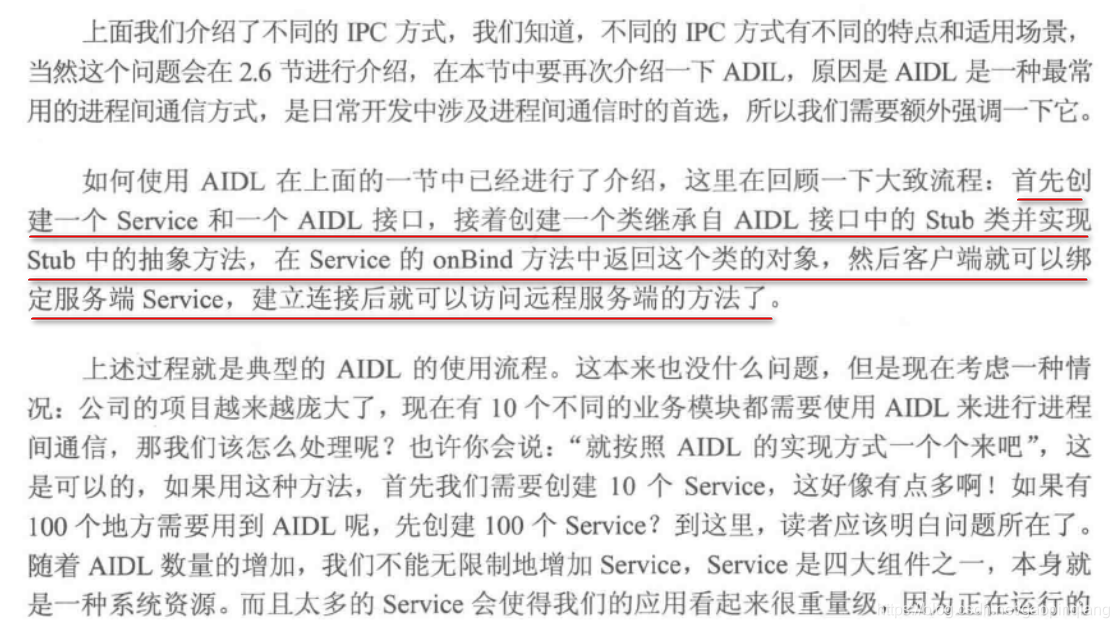


下面通过一个实际的例子演示(已通过本地代码调试运行)
一、服务端代码:
1、我们提供了两个AIDL接口(ISecurityCenter和ICompute)来模拟上面提到的多个业务模块都要使用AIDL的情况,其中ISecurityCenter接口提供解密功能,声明如下:
// ISecurityCenter.aidl
package com.example.binderpoolserver;
// Declare any non-default types here with import statements
interface ISecurityCenter {
String encrypt(String content);
String decrypt(String password);
}
而ICompute提供了计算加法的功能:
// ICompute.aidl
package com.example.binderpoolserver;
// Declare any non-default types here with import statements
interface ICompute {
int add(int a,int b);
}
虽然说上面的两个接口的功能都比较简单,但是用于分析Binder池的工作原理还是足够的,读者可以写出更加复杂的例子。
2、编写上面2个接口的实现
SecurityCenterImpl
package com.example.binderpoolserver;
import android.os.RemoteException;
public class SecurityCenterImpl extends ISecurityCenter.Stub {
private static final char SECRET_CODE = '^';
@Override
public String encrypt(String content) throws RemoteException {
char [] chars = content.toCharArray();
for (int i = 0; i < chars.length; i++) {
chars[i] ^= SECRET_CODE;
}
return new String(chars);
}
@Override
public String decrypt(String password) throws RemoteException {
return encrypt(password);
}
}
ComputeImpl
package com.example.binderpoolserver;
import android.os.RemoteException;
public class ComputeImpl extends ICompute.Stub {
@Override
public int add(int a, int b) throws RemoteException {
return a + b;
}
}
现在的业务模块的AIDL接口定义和实现都已经完成了,注意的是这里并没有为每个模块的AIDL创建单独的Service,接下来就是服务端和Binder连接池的工作了
3、定义Binder连接池的AIDL并实现
IBinderPool
// IBinderPool.aidl
package com.example.binderpoolserver;
// Declare any non-default types here with import statements
interface IBinderPool {
IBinder queryBinder(int binderCode);
}
BinderPoolImpl
package com.example.binderpoolserver;
import android.os.IBinder;
import android.os.RemoteException;
import android.util.Log;
public class BinderPoolImpl extends IBinderPool.Stub {
private static final String TAG = "Server:BinderPoolImpl";
private static final int BINDER_SECURUITY_CENTER = 0;
private static final int BINDER_COMPUTE = 1;
public BinderPoolImpl(){
super();
}
@Override
public IBinder queryBinder(int binderCode) throws RemoteException {
IBinder binder = null;
switch (binderCode){
case BINDER_SECURUITY_CENTER:
binder = new SecurityCenterImpl();
Log.d(TAG,"返回SecurityCenterImpl");
break;
case BINDER_COMPUTE:
binder = new ComputeImpl();
Log.d(TAG,"返回ComputeImpl");
break;
}
return binder;
}
}
4、编写服务端的Service
package com.example.binderpoolserver;
import android.app.Service;
import android.content.Intent;
import android.os.Binder;
import android.os.IBinder;
import android.util.Log;
public class BinderPoolService extends Service {
private static final String TAG = "Server:BPS";
private Binder mBinderPool = new BinderPoolImpl();
@Override
public void onCreate() {
Log.d(TAG,"onCreate");
super.onCreate();
}
@Override
public IBinder onBind(Intent intent) {
Log.d(TAG,"onBind");
return mBinderPool;
}
@Override
public void onDestroy() {
Log.d(TAG,"onDestroy");
super.onDestroy();
}
}
5、服务端的app在AndroidManefest中配置服务(很重要,否则调用失败)
<service android:name="com.example.binderpoolserver.BinderPoolService"
android:exported="true">
<intent-filter >
<action android:name="com.example.binderpoolserver.BinderPoolService"/>
</intent-filter>
</service>
特别注意,android:exported=“true” , 调试的时候遇到了“”“java.lang.SecurityException: Not allowed to bind to service Intent”这个错误。
到这里服务端app的代码已经全部写完了。代码的结构如下:

二、客户端的代码
1、将服务端的aidl包直接拷贝到客户端的工程中,并且build下。
2、Binder连接池具体实现
package com.example.binderpoolclient;
import android.content.ComponentName;
import android.content.Context;
import android.content.Intent;
import android.content.ServiceConnection;
import android.os.IBinder;
import android.os.RemoteException;
import android.util.Log;
import com.example.binderpoolserver.IBinderPool;
public class BinderPool {
private static final String TAG = "Client:BinderPool";
public static final int BINDER_SECURUITY_CENTER = 0;
public static final int BINDER_COMPUTE = 1;
private Context mContext;
private IBinderPool mIBinderPool;
private static volatile BinderPool sInstance;
private BinderPool(Context context) {
mContext = context.getApplicationContext();
connectBinderPoolService();
}
public static BinderPool getInstance(Context context) {
if (sInstance == null) {
synchronized (BinderPool.class) {
if (sInstance == null) {
sInstance = new BinderPool(context);
Log.d(TAG, "创建Binder连接池");
}
}
}
return sInstance;
}
private synchronized void connectBinderPoolService() {
final Intent service = new Intent();
Log.d(TAG, "第一种启动服务方式,推荐使用");
service.setComponent(new ComponentName("com.example.binderpoolserver", "com.example.binderpoolserver.BinderPoolService"));
// service.setAction("com.example.binderpoolserver.BinderPoolService");
// service.setPackage("com.example.binderpoolserver");
Log.d(TAG, "第二种启动服务的方式");
Log.d(TAG, "service.setAction(\"com.example.binderpool.service\");");
Log.d(TAG, "service.setPackage(\"com.example.binderpool.server\");");
mContext.bindService(service, mBinderPoolConnection, Context.BIND_AUTO_CREATE);
}
public IBinder queryBinder(int binderCode) {
IBinder binder = null;
try {
if (mIBinderPool != null) {
binder = mIBinderPool.queryBinder(binderCode);
}
} catch (RemoteException e) {
e.printStackTrace();
}
return binder;
}
private ServiceConnection mBinderPoolConnection = new ServiceConnection() {
@Override
public void onServiceConnected(ComponentName name, IBinder service) {
Log.d(TAG, "onServiceConnected");
mIBinderPool = IBinderPool.Stub.asInterface(service);
Log.d(TAG, "设置死亡代理");
try {
mIBinderPool.asBinder().linkToDeath(mBinderPoolDeathRecipient, 0);
} catch (RemoteException e) {
e.printStackTrace();
}
}
@Override
public void onServiceDisconnected(ComponentName name) {
}
};
private IBinder.DeathRecipient mBinderPoolDeathRecipient = new IBinder.DeathRecipient() {
@Override
public void binderDied() {
mIBinderPool.asBinder().unlinkToDeath(mBinderPoolDeathRecipient, 0);
mIBinderPool = null;
Log.d(TAG, "重连服务");
connectBinderPoolService();
}
};
}
3、在MainActivity中使用
package com.example.binderpoolclient;
import android.os.Bundle;
import android.os.IBinder;
import android.os.RemoteException;
import android.util.Log;
import android.view.View;
import androidx.appcompat.app.AppCompatActivity;
import com.example.binderpoolserver.ICompute;
import com.example.binderpoolserver.ISecurityCenter;
public class MainActivity extends AppCompatActivity {
private static final String TAG = "Client:MainActivity";
BinderPool binderPool;
private ISecurityCenter mSecurityCenter;
private ICompute mCompute;
@Override
protected void onCreate(Bundle savedInstanceState) {
super.onCreate(savedInstanceState);
setContentView(R.layout.activity_main);
binderPool = BinderPool.getInstance(this);
}
public void callSecurity(View v) {
new Thread() {
@Override
public void run() {
Log.d(TAG, "callSecurity");
IBinder securityBinder = binderPool.queryBinder(BinderPool.BINDER_SECURUITY_CENTER);
mSecurityCenter = ISecurityCenter.Stub.asInterface(securityBinder);
if (mSecurityCenter != null) {
String msg = "Android";
try {
String password = mSecurityCenter.encrypt(msg);
Log.d(TAG, "encrypt message = " + password);
String decrypt = mSecurityCenter.decrypt(password);
Log.d(TAG, "decrypt message = " + decrypt);
} catch (RemoteException e) {
e.printStackTrace();
}
} else {
Log.d(TAG, "mSecurityCenter = null");
}
}
}.start();
}
public void callCompute(View v) {
Log.d(TAG, "callCompute");
IBinder computeBinder = binderPool.queryBinder(BinderPool.BINDER_COMPUTE);
mCompute = ICompute.Stub.asInterface(computeBinder);
if (mCompute != null) {
try {
int result = mCompute.add(3, 5);
Log.d(TAG, "compute result = " + result);
} catch (RemoteException e) {
e.printStackTrace();
}
} else {
Log.d(TAG, "mCompute = null");
}
}
}
疑问:主线程中调用远程服务是否会导致ANR?
答案是会的,因为客户端调用了远程的服务,客户端的线程就挂起了,直到服务器返回结果。
例如:

客户端的打印也是有6秒等待的。

布局文件为:
<?xml version="1.0" encoding="utf-8"?>
<LinearLayout xmlns:android="http://schemas.android.com/apk/res/android"
xmlns:app="http://schemas.android.com/apk/res-auto"
xmlns:tools="http://schemas.android.com/tools"
android:layout_width="match_parent"
android:layout_height="match_parent"
app:layout_behavior="@string/appbar_scrolling_view_behavior"
tools:context=".MainActivity"
tools:showIn="@layout/activity_main"
android:orientation="vertical"
>
<Button
android:layout_width="wrap_content"
android:layout_height="wrap_content"
android:text="callSecurity"
android:onClick="callSecurity"
/>
<Button
android:layout_width="wrap_content"
android:layout_height="wrap_content"
android:text="callCompute"
android:onClick="callCompute"
/>
</LinearLayout>
到这里,客户端的代码就写完了,不出问题可以正常运行了。
特别注意:运行的时候,先要启动服务端的app,否则绑定不了服务
代码的结构如下:

看看运行的结果:

成功调用到了远程的服务方法。
有了BinderPool可以大大方便日常的开发工作,比如如果有一个新的业务模块需要添加新的AIDL,那么在他实现自己的AIDL接口后,只需要修改BinderPoolImpl中的queryBinder方法,给自己添加新的binderCode并返回对应的Binder对象就可以,不需要做其他的修改,也不需要创建新的Service,由此可见,BinderPool能够极大的提高对AIDL的开发效率,并且可以避免大量的Service创建,因此比较建议使用。
三、选择合适的IPC方式
我们介绍了各种各样的IPC方式,那么到底它们有什么不同呢?我到底该使用哪一种呢?本节就为读者解答这些问题,具体内容如表所示。通过表可以明确地看出不同IPC方式的优缺点和适用场景,那么在实际的开发中,只要我们选适的IPC方式就可以轻松完成多进程的开发场景。

